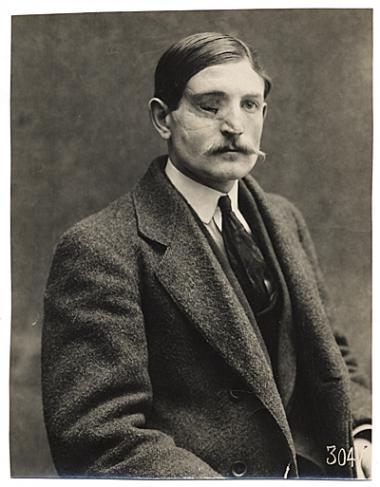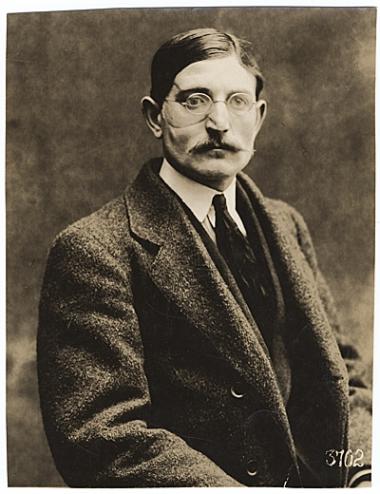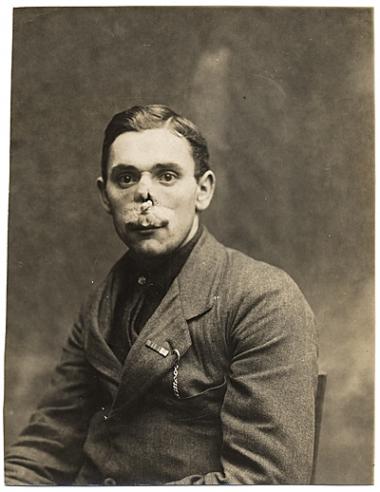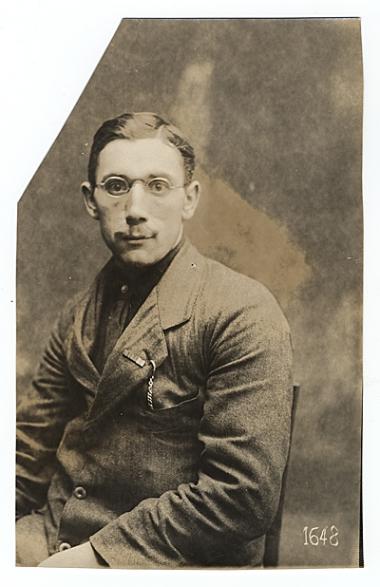October 8, 2014 - 19:45

What happens when your face is no longer yours? How can you ever feel like a whole self again, when your face no longer represents you? Faces are one of the main ways that we humans form conceptions of ourselves, and they are our method of taking in sensory information, as well as communicating with each other.
This was the dilemma that faced many Allied veterans of World War I. The trench warfare they fought in and endured has been described as hellish muck, among other things. Unfortunately, one of the most common outcomes of trench warfare was injury to the face. A soldier would stick their head out of the trench, and lo--a shell explodes, a face is gone, if one’s lucky enough to survive. Those men that did survive were horribly disfigured. Along with the horrors of war, the disfigurement could rob these veterans of their senses of self, both social and personal, even down to their very sense of their masculinity. [1]
To help the healing process, the former Allied armies sponsored artists to create "portrait masks" for the afflicted veterans, a form of facial prosthetic, so they could regain some sense of a normal life. The work of Anna Coleman Ladd, as profiled by NPR in this recent story, is one of the most remarkable examples of portrait masks. A locally known sculptural artist, (and native of Bryn Mawr, PA), she was found by Dr. Sir Harold Gillies, a pioneer at the time of reconstructive surgery, and asked for her to take her sculptural talent and open up the Studio for Portrait Masks in Paris in late 1917 (Alexander 1). She had an incredibly detailed process to creating these masks in her studio, much like the process Riva Lehrer discussed with us in class, about her artistic process in painting a portrait. [2]
Instead of attempting to photographically re-create the face a veteran once had, Ladd sought instead to make a portrait of the man themselves. She sought to get to know them, their families, their personal preferences, and not just use photos of how they looked before the war. The masks she and her studio would make were made primarily of copper, plaster, and paint, fitted custom to each person's face. She and her staff would take casts of each man’s face, and the unique way in which they had healed and been reconstructed, so that they could fit the mask exactly to the contours of each individual’s face. [3] (This also minimized the amount of ties needed to attach the mask to the head) The masks themselves were essentially wearable portraits, at the same time they were prosthetic devices—an unlikely hybrid.
However, these masks were not "functional" prosthetics--they couldn't move or be used to eat, for instance. They would always be set in one expression, one skin tone, and could not move. When we think of a prosthetic, we usually think of something functional, something moveable. We think of hands, of legs, of even implanted eyes. Faces, though, are not moveable appendages like limbs. Faces are the sensory and intake centers of the body, but more than that, they are highly evolved methods of social communications. Thus, these masks are not so much "functional" prosthetics as social prosthetics. Ladd chose to construct these prosthetics as portraits of how the men wished to be seen. Let us look at three examples of Ladd’s work.

Though they might be tricks of the light, and appear very similar at first glance, these two portraits of a patient of Ladd's actually have remarkable differences other than the obvious (that is, the mask). Common to both portraits is the haircut, the major positioning of the body, and the outfit. Even the background and the chair are the same. The haircut is a typical style of the time-period, waxed into place with hair cream, a standard man’s haircut. The subject wears his uniform, though I’m not sure whether it’s his duty or his dress uniform (likely dress), with all of his medals pinned in full view, front and centered. The general pose is a typical portrait bust pose, meant to show off and accentuate the natural shape of the shoulders. It was also typical, as in many portraits today, for the subject to be looking straight at the viewer. His gaze is strong and steady, almost confrontational in its directness, as if he were trying to look through the picture and into your eyes (or, in the case of the photographer, through the lens and to the cameraman’s eyes). Clearly, these two portraits must have been taken minutes apart—virtually every hair is in the same place.
Other than the obvious change of no mask to mask on, the fine details are where you can find many social cues. In the left-hand portrait, the man is slightly slouched, showing how conscious he is of the deformity of his face. Even though he looks straight at the viewer, his chin is slightly turned away off the typical 45 degree angle of this portrait pose. The little area of his face that he is able to show expression in, his eyes, are steady and almost challenging, even as they have a concealed mournfulness to them. He is proud of his service and sacrifice at the same time he knows the effect on others of his tragic deformity. By contrast, in the right-hand picture, the man sits straighter up, shoulders squared in pride, the entire picture brighter in tone. He stares at you much straighter-on—the semblance of normalcy, of not being so starkly ugly, has given him back enough confidence to take more pride in the medals on his chest.
His unmasked face is what society even now considers the stuff of horrors. He lacks much of his nose, his mouth has been misshapen, and he likely lacks much of the zygomatic (cheek) bone on the right side of his face—flesh is missing all around it. And this is after reconstructive surgery!


Similar features and expressions can be seen in these next two sets of portraits taken of Ladd’s patients. Many of the compositional elements of these two paired portraits are similar: the traditional pose, glasses, and period-typical haircuts. In these, however, there are no medals to be seen—instead, they seem to be trying to reclaim their normality of life by dressing in laymen’s formal garb. They too display similar emotional cues in their body language: in the first portrait of each set, they look just off-center, not at the camera. Their body language is hunched-over, protective, ashamed of a deformity that is unable to be concealed. In the second portrait, they look at the camera head-on, with pride, shoulders squared, their shame-filled injuries hidden and their faces revealed.


Misshaping and deforming of this type will often bring to mind visions of mortality for the viewer, as well as a sheerly visceral sense of horror at something so uncanny. These such injuries bring remiscences of the horrors of war, a reminder for both the person, daily, of the horrors they suffered in the trenches, and for their loved ones. Even for people on the street, when they did indeed venture out, were a sight of horror.
These masks were made as portraits of who the wearer wanted to be seen as, as best as was able with the technology of the World War I era. They were prosthetics which allowed veterans to lead more normalized lives, to be seen as something more than their wartime injuries. The chief principle of the mask is one of concealment, but the portrait’s chief principles include representation and revelation. When their faces could no longer represent them, the portrait masks of Anna Coleman Ladd helped these injured veterans of World War I. Their faces, once masked by injury, were revealed by these wearable portraits.
References & Works Cited
Alexander, Caroline. "Faces of War." Smithsonian Magazine 1 Feb. 2007. Print.
Biernoff, Suzannah. "The Rhetoric of Disfigurement in First World War Britain." Social History of Medicine 24.3 (2011): 666-85. Print.
NPR Staff. "One Sculptor's Answer To WWI Wounds: Plaster, Copper And Paint." National Public Radio: All Things Considered. 25 Sept. 2014. Web. 4 Oct. 2014. <http://www.npr.org/2014/09/25/351441401/one-sculptors-answer-to-wwi-wounds-plaster-copper-and-paint>.
WWI soldier facial reconstruction documentation photograph, circa 1920. Record #s 8370, 8371, 8372, 8373, 8375, 8376. American Red Cross, photographer. Anna Coleman Ladd papers, Archives of American Art, Smithsonian Institution.
[1] See Suzannah Biernoff's "The Rhetoric of Disfigurement in First World War Britain" for an excellent and deep discussion of the social implications of disfigurement for veterans in society.
[2] For more information, have a look around her website at http://www.rivalehrerart.com/
[3] This video of archival footage provides an excellent illustration of the process: https://www.youtube.com/watch?v=bCSzrUnie2E
